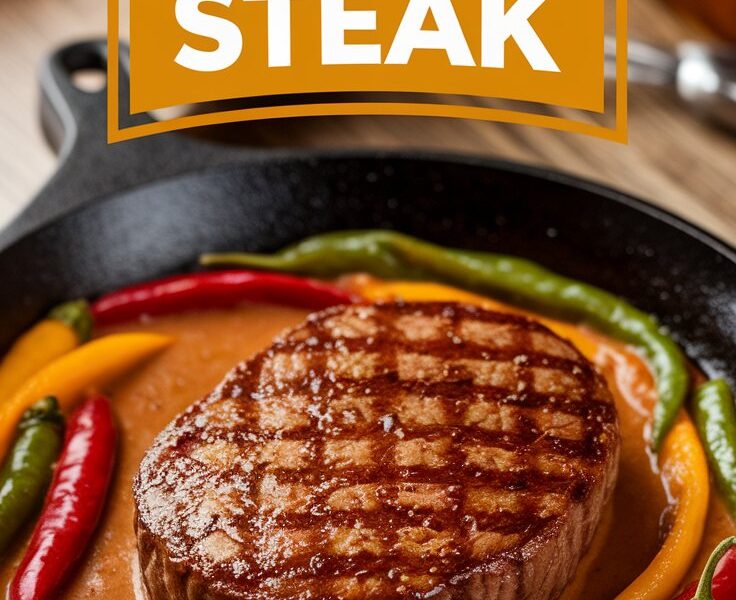Every family has those special dishes that bring everyone to the table, fill the house with irresistible aromas, and warm the heart with memories. For many, one of those dishes is Old-Fashioned Swiss Steak.
It’s a classic American comfort food that has been passed down through generations—affordable, filling, and deeply satisfying. What makes this dish unique is not just its taste but also its clever use of simple ingredients to transform inexpensive cuts of beef into a meal that feels indulgent.
Imagine fork-tender beef simmered in a savory tomato-based gravy, infused with onions, peppers, and celery. Served over fluffy mashed potatoes or buttered noodles, it’s the kind of food that makes you slow down and savor each bite.
This guide goes far beyond a simple recipe. Here, you’ll learn everything about Swiss steak—from its origins and ingredient secrets to expert cooking techniques, creative variations, serving ideas, and storage tips. Whether you’re preparing Sunday dinner, looking for a hearty family meal, or simply exploring old-fashioned recipes, this article has you covered.
What Is Swiss Steak and Why Is It Called “Swiss”?
Despite what the name suggests, Swiss Steak has nothing to do with Switzerland. Instead, the term “Swiss” refers to the culinary technique of swissing, which means tenderizing meat by pounding, rolling, or scoring before cooking.
In the early 20th century, when families often relied on tougher cuts of beef like round or chuck steak, cooks needed ways to make these cuts tender and delicious. The swissing method, combined with slow braising in flavorful liquids, created a meal that was both budget-friendly and hearty.
The result? Beef so tender you can cut it with a fork, surrounded by a rich tomato-onion gravy that pairs beautifully with comforting sides.
Today, Swiss steak is celebrated not only as a nostalgic dish from Grandma’s kitchen but also as an example of how traditional cooking techniques can elevate simple ingredients.
Why Old-Fashioned Swiss Steak Is Still Loved Today
There’s a reason Swiss steak has endured for decades—it’s versatile, forgiving, and soul-warming. Here’s why it continues to win hearts:
- Affordable & Accessible: Uses budget-friendly cuts of beef and pantry staples.
- Crowd-Pleaser: Loved by adults and kids alike, making it perfect for family meals.
- Versatile Cooking Methods: Can be made in a skillet, Dutch oven, oven, or slow cooker.
- Meal Prep Friendly: Tastes even better the next day, and freezes well.
- Customizable: Can be spicy, smoky, creamy, or veggie-packed depending on your mood.
In a world of fast food and complicated recipes, Swiss steak is refreshingly simple yet deeply satisfying.
Ingredients for Old-Fashioned Swiss Steak (With Measurements & Benefits)
For 4–6 servings, here’s the ingredient list with notes on why each one matters:
- 2 pounds beef round steak (¾–1 inch thick) → Best balance of affordability and flavor; benefits from long cooking.
- ½ cup all-purpose flour → Coats the beef, helping with browning and thickening the sauce.
- 1 teaspoon salt + ½ teaspoon black pepper → Basic seasoning for balance.
- 1 teaspoon paprika → Adds warmth and mild smokiness.
- 2 tablespoons vegetable oil or olive oil → For searing and flavor development.
- 1 medium onion, sliced → Builds sweetness and depth in the gravy.
- 1 green bell pepper, sliced → Adds freshness and a mild tang.
- 2 celery stalks, sliced → Brings subtle earthiness and texture.
- 3 cloves garlic, minced → Essential for aroma and richness.
- 1 can (14.5 oz) diced tomatoes with juice → The base of the gravy.
- 1 tablespoon tomato paste → Concentrated flavor for a deeper tomato profile.
- 1½ cups beef broth → Adds body and keeps the beef moist.
- 1 teaspoon Worcestershire sauce → Savory umami boost.
- ½ teaspoon dried thyme → Earthy, herbal flavor.
- Fresh parsley (optional, for garnish) → Brightens the finished dish.
This ingredient combination is classic, but you’ll soon see how easy it is to tweak based on your preferences.
Equipment Guide: Choosing the Best Tools
Swiss steak is flexible and can be cooked in many ways. Here’s what works best:
- Cast-Iron Skillet or Dutch Oven → Ideal for stovetop-to-oven cooking; develops deep flavor.
- Deep Sauté Pan → Perfect if you’re simmering entirely on the stovetop.
- Slow Cooker → Best for hands-off cooking; results in melt-in-your-mouth beef.
- Baking Dish + Foil → A budget-friendly alternative if you don’t have heavy cookware.
Whichever method you choose, the secret is consistent low heat and enough liquid to keep the beef tender.
Step-by-Step Guide to Making Swiss Steak
Step 1: Prepare the Meat
Trim excess fat. Mix flour, salt, pepper, and paprika in a shallow dish. Dredge the beef pieces in seasoned flour. This helps brown the meat and thicken the gravy later.
Step 2: Brown the Beef
Heat oil in your skillet or Dutch oven over medium heat. Brown the steak on both sides, 2–3 minutes per side. Don’t skip this step—it develops flavor and color. Remove and set aside.
Step 3: Sauté Vegetables
In the same pan, add onion, bell pepper, celery, and garlic. Cook until softened, about 5–7 minutes.
Step 4: Build the Sauce
Stir in tomato paste, diced tomatoes, broth, Worcestershire sauce, and thyme. Mix well and bring to a simmer.
Step 5: Combine & Simmer
Return beef to the pan. Nestle it into the sauce, spooning some gravy on top.
Step 6: Low & Slow Cooking
- Stovetop: Simmer on low for 1.5–2 hours.
- Oven: Bake at 325°F (160°C) for the same time.
- Slow Cooker: Cook on low for 7–8 hours or high for 4 hours.
The beef should be fork-tender when ready.
Step 7: Serve
Garnish with fresh parsley and serve hot with mashed potatoes, rice, or egg noodles.
Expert Tips for Perfect Swiss Steak
- Tenderize First → Lightly pound steak with a mallet for even cooking.
- Brown for Flavor → Searing caramelizes the meat and deepens taste.
- Don’t Rush → Low and slow is the secret to tenderness.
- Adjust Seasoning → Taste before serving and add salt, pepper, or Worcestershire as needed.
- Enhance Sauce → Add red wine, smoked paprika, or mushrooms for depth.
Flavor Variations
Swiss steak is adaptable. Try these twists:
- Spicy → Add red pepper flakes or jalapeños.
- Smoky → Use fire-roasted tomatoes or smoked paprika.
- Creamy → Stir in sour cream at the end for a creamy gravy.
- Mushroom Lovers → Add sliced mushrooms with the onions.
- Wine-Infused → Replace some broth with red wine for richness.
Serving Suggestions
Pair Swiss steak with sides that balance its richness:
- Mashed potatoes or buttered egg noodles (classic choice).
- Steamed green beans, roasted carrots, or peas.
- Fresh salad with vinaigrette to lighten the plate.
- Crusty bread or dinner rolls to soak up gravy.
This dish shines at Sunday family dinners but also works for weeknight comfort meals.
Leftover Ideas
Don’t waste leftovers—they’re even better the next day. Try:
- Sandwiches → Shredded beef on hoagie rolls with cheese.
- Stuffed Potatoes → Top baked potatoes with steak and gravy.
- Pasta Toss → Stir into pasta with extra sauce.
- Steak Hash → Sauté with diced potatoes and peppers for breakfast.
Common Mistakes to Avoid
- Using lean cuts like sirloin (they dry out).
- Skipping the browning step (flavor loss).
- Cooking at high heat (leads to toughness).
- Forgetting to cover (moisture escapes).
- Adding delicate veggies too early in a slow cooker (they’ll turn mushy).
Storage, Freezing, and Reheating
- Store: Refrigerate leftovers in airtight containers up to 4 days.
- Freeze: Freeze portions for up to 2 months. Thaw in the fridge overnight before reheating.
- Reheat: Warm gently on the stovetop or in the microwave with a splash of broth.
Meal prep tip: Double the recipe and freeze half for quick future dinners.
Nutrition Info (Per Serving, Based on 6 Servings)
- Calories: ~385
- Protein: 32 g
- Fat: 20 g
- Saturated Fat: 6 g
- Carbohydrates: 12 g
- Fiber: 2 g
- Sugar: 4 g
- Sodium: 510 mg
- Iron: 18% DV
Healthier swap: Use low-sodium broth and trim fat for a lighter version.
Old-Fashioned Swiss Steak FAQs
Q: Can I use cube steak instead of round steak?
Yes, cube steak works well because it’s already tenderized.
Q: Can I make it without tomatoes?
Yes, substitute with beef broth and add mushrooms or onion gravy.
Q: What’s the best side dish?
Mashed potatoes are traditional, but rice or noodles are also excellent.
Q: Can I prepare this in advance?
Absolutely! It tastes even better the next day.
Q: How can I make it gluten-free?
Use gluten-free flour or cornstarch for dredging.
Final Thoughts
Old-Fashioned Swiss Steak is more than just a recipe—it’s a reminder of the value of slow cooking, simple ingredients, and meals that bring families together. It shows how creativity in the kitchen can turn humble cuts of meat into a dish that feels special and nourishing.
Whether you’re hosting a Sunday dinner, meal-prepping for the week, or recreating a nostalgic family favorite, this recipe delivers comfort in every bite.



